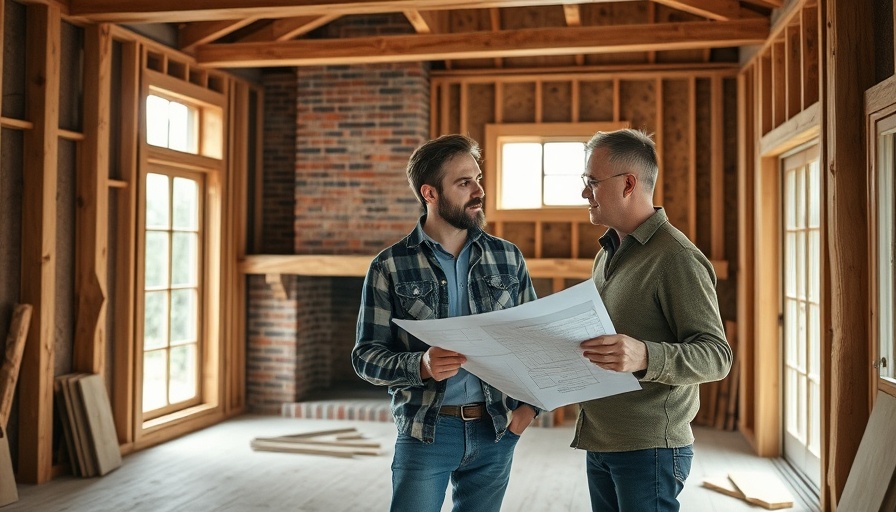
Knowing When to Call in the Pros: The Case for Hiring an Interior Designer
Transforming a space into a personalized oasis can feel daunting, especially for homeowners keen on achieving an exceptional aesthetic. From busy professionals managing hectic schedules to those grappling with large remodels, the decision to hire an interior designer often proves worthwhile. Here’s why considering a professional could be the game-changer you didn’t know you needed.
Why Choose Professionals for Timing and Quality?
When tackling extensive remodeling projects, timelines can become unpredictable. Whether it's adhering to safety standards, navigating building codes, or aligning various components, a competent interior designer will keep your project on track. Their ability to manage these challenges can efficiently eliminate stress and prevent significant delays, ensuring your design journey is both seamless and satisfying.
Achieving a Cohesive Look in Your Favorite Room
Is one specific room a constant source of frustration? It could be your living room, kitchen, or bedroom. Interior designers have the expertise to pull your vision together, crafting spaces that inspire relaxation and enjoyment. By utilizing their skilled judgement on textures, colors, and overall layout, they can curate a polished environment tailored to your tastes. A well-designed space can elevate moments spent there — perfect for family gatherings or hosting friends.
Stepping Past DIY Limitations: Embracing Professional Help
DIY may be tempting and can certainly yield rewarding results. However, recognizing when to reach for professional help can enhance the outcome more than one might expect. A designer brings valuable industry insights and resources, proving beneficial during those overwhelming times when too many choices stall progress. They offer guidance, ensuring that even the smallest details align with your broader vision. This kind of support fosters a completion mindset, as focusing on the bigger picture encourages decisive action.
Combining Functionality with Style: Interior Design Essentials
Whether it's maximizing limited square footage or ensuring traffic flows fluidly within the space, inserting functionality into design is vital. Designers possess the ability to address these elements while also aligning with aesthetic preferences. They can enhance space usability without compromising on style, resulting in environments that feel both comfortable and chic.
Insights from Local Designers: Understanding the California Vibe
California homes often reflect vibrant styles, emphasizing indoor-outdoor versatility and eco-friendly elements. Local designers are attuned to regional aesthetics and sustainability trends, incorporating natural elements and maximizing light to suit California’s lively culture. Understanding this unique perspective can significantly impact your design choices, ensuring that your home feels like a true reflection of its surroundings.
Bridging Mental Gaps: The Emotional Impact of Design
Our surroundings deeply influence our emotional well-being. Spaces filled with chaotic colors or mismatched furniture can evoke stress, while a well-designed room promotes comfort and relaxation. Hiring an interior designer can help align your space with your lifestyle and emotional needs, offering you a sanctuary that supports mental clarity and peace.
Common Misconceptions About Hiring Designers
Many homeowners shy away from the idea of hiring an interior designer, often due to misconceptions about cost or the belief that it undermines their personal creativity. In reality, a designer collaborates with you, translating your vision into a reality that you may not have been able to achieve alone. Understanding that their role is to enhance, rather than replace, your creative input can open doors to exceptional results.
Understanding How to Collaborate with Your Designer
Effective collaboration is key to transforming your space successfully. As clients, knowing how to communicate your needs and lifestyle preferences to your designer can make a significant difference. Establishing a clear vision upfront allows them to tailor options to your specifications, ensuring the final design resonates with your personality.
Deciding to Take the Leap: Your Next Steps
Choosing to work with an interior designer can elevate your living space, enhance functionality, and enrich your life. Whether you’re looking for a complete overhaul or just need a fresh perspective, embracing professional guidance might be your best decision yet. Start exploring local options today, and see how a designer can take your space from mundane to magnificent!
If you're ready to embark on this journey, consider searching for a qualified interior designer who can understand your needs and preferences. Investing in expertise can save time, reduce stress, and ultimately create a home you'll love for years to come.
 Add Row
Add Row  Add
Add 




Write A Comment